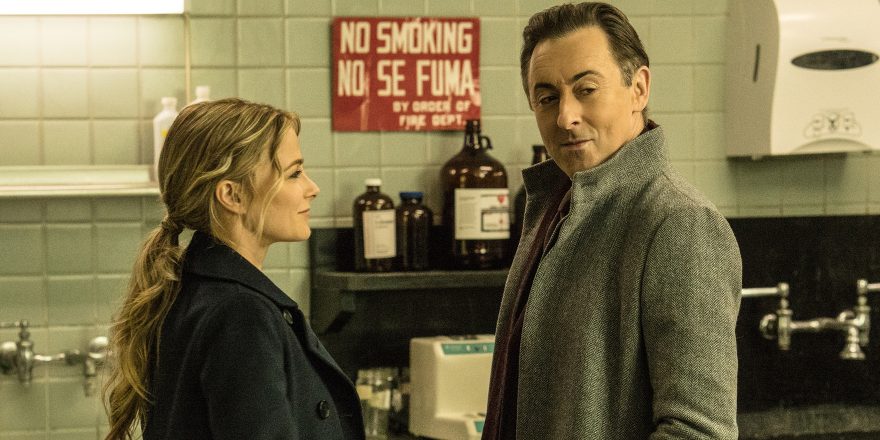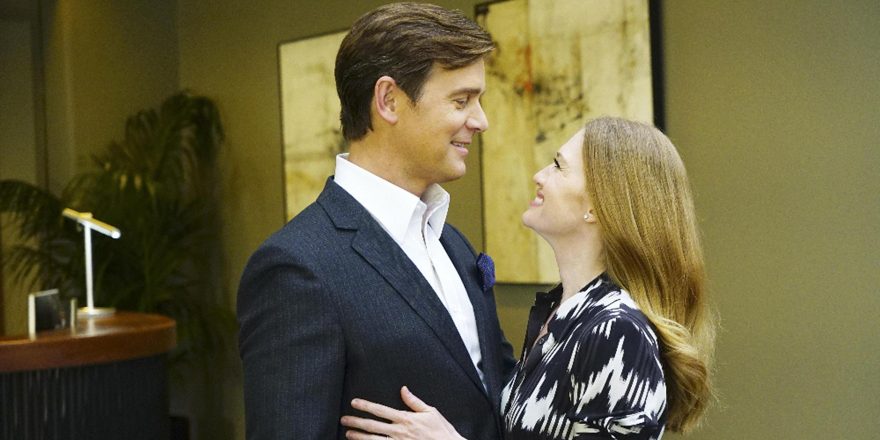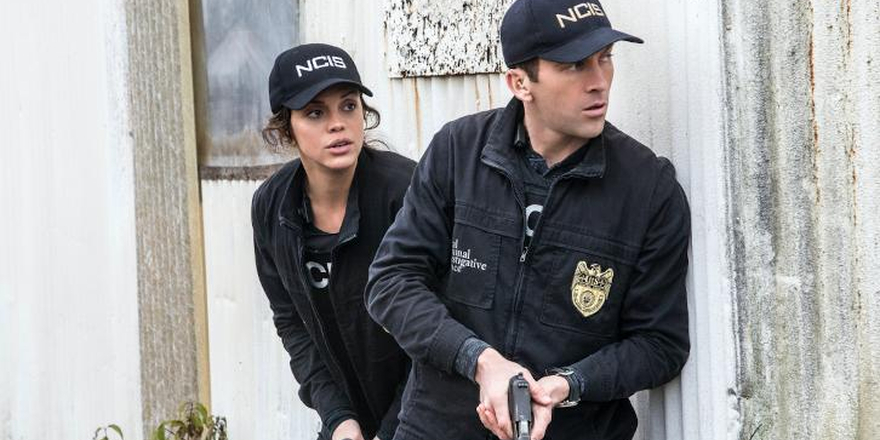The publicity around the new CBS series Instinct has largely focused on the show’s status as the first network procedural to feature an openly gay protagonist, an expert in abnormal psychology played by Alan Cumming. The premise of the show, adapted by creator Michael Rauch from James Patterson and Howard Roughan’s novel Murder Games, is that Cumming’s character Dylan Reinhart has left the CIA for academia for the sake of his marriage to bar owner Andy (Daniel Ings); yet when NYPD detective Lizzie Needham (Bojana Novakovic), asks him for assistance, he can’t resist jumping back into the world of criminal profiling, and before long he and Needham are partners solving a variety of colorful crimes. Based on this description, Instinct probably doesn’t sound particularly original – the echoes of other lightly comic mystery series featuring a man and woman at the center (Castle, Elementary, etc.) are fairly obvious. What makes Instinct stand out, however, is the way in which Rauch and his writers consistently find new variations on familiar themes. The slight shifts in emphasis and tweaks to formula have a cumulative effect that results in a show smarter and funnier than one could reasonably expect.
Dylan’s sexual orientation is both emblematic of why the show works and only one small factor in its success. On the one hand, the show doesn’t labor over the hero’s sexuality; it’s taken as matter of self-evident fact, and addressed no more or less often on the series than it would be if Cumming were playing a heterosexual character. Yet making Dylan gay has a ripple effect throughout the show that ends up being fairly revolutionary in terms of the ways in which it reinvents the tradition to which Instinct belongs. The badinage between Dylan and Lizzie has its roots in ’40s romantic comedies like His Girl Friday and The Philadelphia Story, which have seen their style appropriated by dozens of popular TV shows, including Moonlighting and the aforementioned Castle. Surprisingly, the ping-ponging repartee is more rather than less entertaining when the “will they or won’t they” aspect of romantic tension is removed from the equation; the fact that there’s no possibility that Dylan and Lizzie will ever sleep together both removes a key problem for the show’s creators (no danger of the air going out of the balloon like it did when, for example, Sam and Diane finally got together on Cheers) and more sharply focuses both the characters and the audience on what they’re actually saying. The banter no longer seems like a substitute for sex, it’s action in and of itself – Rauch and his writers infuse the verbal sparring not with innuendo but with substantive analysis, as Dylan and Lizzie put their heads together to solve their various cases.
Ironically, it makes Instinct an incredibly sexy show even though it’s not about sex – there’s something inherently stimulating about the way these characters use their brains. A lot of procedurals attempt this kind of thing, but few actually achieve it – possibly because to create genuinely smart characters you need, yes, genuinely smart writers. Instinct has them, and it also has very compelling stars in the form of Cumming and Novakovic. Cumming’s character is an interesting reversal of a type that was big in American movies of the 1990s, the mentally superhuman serial killer. Like Hannibal Lecter and, to a lesser extent, John Doe in Se7en, Dylan Reinhart has an almost supernatural intelligence and ability to read anyone with whom he comes into contact; the obvious difference is that here there’s no moral murkiness in our identifying with him, since he’s the hero – he’s not a sociopath like Doe or Lecter, or even an antihero like Will Graham in Michael Mann’s Manhunter. Dylan draws upon all of these characters, who provide the audience with cathartic power fantasies of domination and supremacy, without exploiting the viewer’s baser instincts – he’s as charming as Lecter and as intelligent as Graham, but with a pure heart. Cumming plays the character with great skill, taking elements that could seem contrived or silly in lesser hands – like Dylan’s “phonographic” memory – and making them genuinely revelatory and convincing. He’s brilliant enough to hold our interest but not unbelievably so, and his internal struggles over the tension between his own urge to get close to the dark side of human nature and his obligations to his husband are conveyed with delicacy and nuance. In a less flashy role, Novakovic is every bit Cumming’s equal, breezily letting the comic dialogue fly off her tongue without ever resorting to superficial interpretations or a predictable delivery – her wit feels organic, not forced by self-conscious attempts at being clever. And when she has to go a little more serious, in the moments that refer to her tragic past, Novakovic expresses deep, profound heartbreak without straining for it – like the show as a whole, she’s got the confidence to know what she’s capable of delivering without pushing.
The strong acting and writing on Instinct are well served by an admirably strong stable of directors. The first episode is directed by 500 Days of Summer auteur Marc Webb and the second is by Doug Aarniokoski, who’s done excellent work on the similarly snappy Bull and many other series; he also directed the enjoyably nasty and darkly hilarious horror film Nurse. Webb’s pilot kicks the series off in high style, with a vibrant set piece that synthesizes the palette and compositional approaches of Dressed to Kill and 25th Hour with ingenuity and dynamism. Yet in his own subtler way, Aarniokoski brings an even more impressive eye to the show, evolving its visual style in his “Wild Game” episode by bringing an Antonioni-esque sense of architecture as an expressive tool into the mix. Avoiding the overreliance on close-ups so typical of television, Aarniokoski places enormous emphasis on contextualizing the characters within their environments, framing them in a manner that reflects and expands character and theme: for example, orderly straight lines and large windows for Dylan, who’s rigorous and straightforward yet feels a world he had been trying to keep at bay moving in on him – an idea that’s developed by contrast when he’s at home in his safe haven with Andy in a space that’s all soft light and soft edges, with no glimpse into the outside world. And the energy of Aarniokoski’s camera moves are dictated by the energy of the characters and performances rather than externally imposed in the way that it is common to so many TV shows (and films, for that matter), where an unmotivated whirling camera is somehow supposed to gin up a sense of excitement. Here the excitement begins with the writing, is deepened by the performances, and then accentuated by Aarniokoski and cinematographer Joe Collins’ elegant gliding camera. (The Steadicam operator, Edgar Colón, deserves a shout-out here – he and the actors interact in a kind of sophisticated dance that elevates standard walk-and-talks to the level of art.) It’s fully integrated filmmaking that rewards repeat viewings, as do the scripts; unlike some shows written under the brutal deadlines of network television, these murder mysteries hold up under scrutiny, and are as compelling when we know the solutions as when we don’t. That’s because, like Dylan Reinhart, Rauch and his collaborators seem to have a boundless curiosity and infinite wisdom when it comes to human behavior – and the upshot of their enthusiasm crossed with their ambition to breathe new life into a shopworn genre is the first great new show of 2018.







